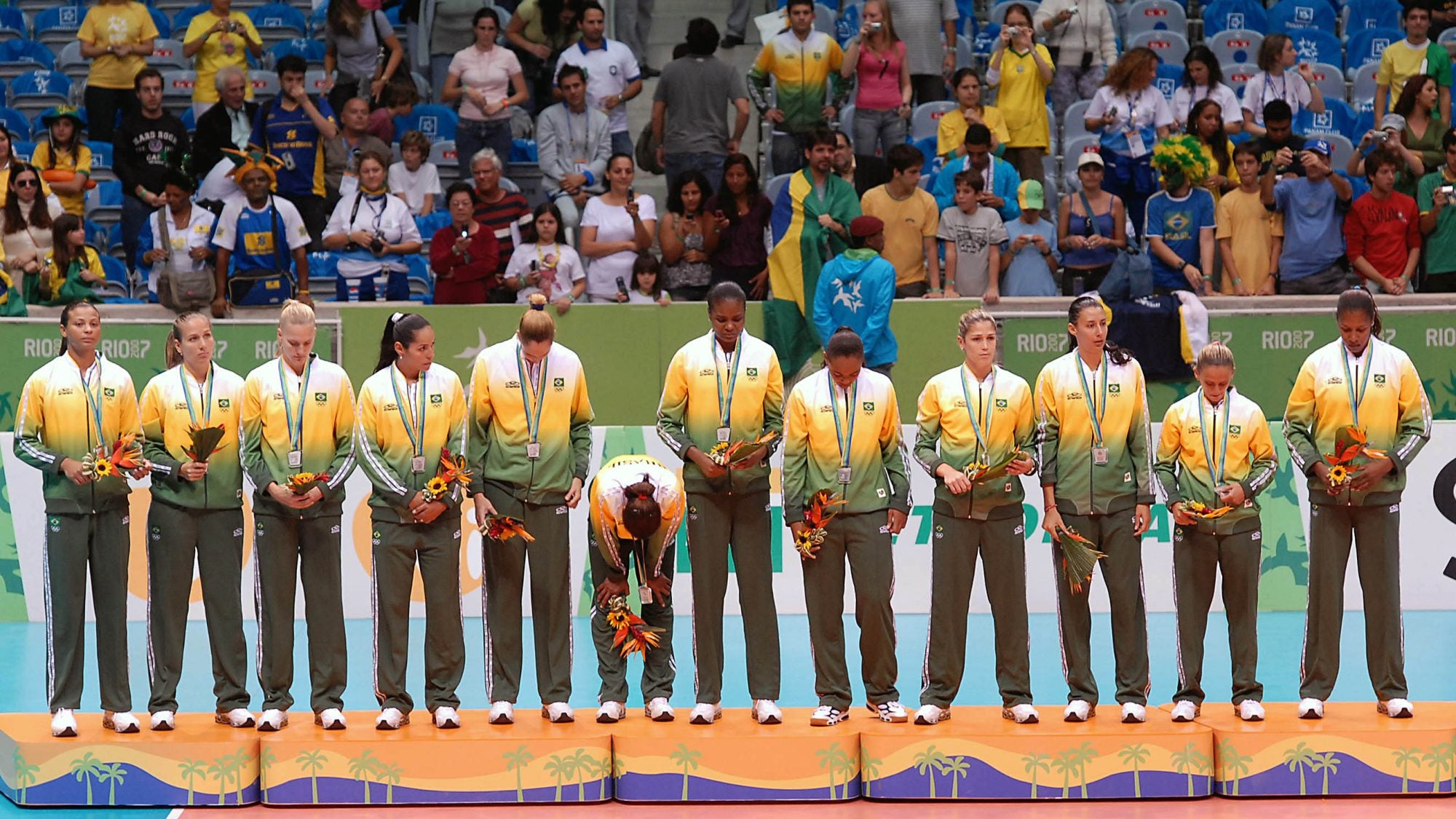
Title: Volleyball Nation: Brazilian Women’s Vôlei
For most of the last ten years one of the stars of the Brazilian women’s volleyball team was a stunning, 6’3”middle-blocker named Walewska Oliveira. When Walewska spiked, her normally jovial features contorted temporarily in a terrifying grimace as she stuffed her opponents. Walewska was never better than in Brazil’s dismantling of the US team in the gold-medal match in 2008. On repeated points, she unleashed her power, sending the ball careening off the hands of helpless opponents—and out of bounds. Then she turned away from the net, embraced teammates, returned to her spot and primly adjusted her hair-band. Power, solidarity, grace: the essence of Brazilian volleyball.
You might think of Brazil as soccer nation, but Brazil is now more successful in international volleyball than it is in soccer. Brazil has won more Olympic medals in volleyball than in any other sport except sailing—and nobody thinks of Brazilians as the world’s best sailors. Volleyball is another story: Brazilian teams changed the game in the 1990s and most of the world is still struggling to catch up.
Brazil’s rise to volleyball preeminence coincides with the recent emergence of a new middle class—acquisitive, resourceful and competitive. And it echoes Brazil’s new global role, based on its mastery of commodities—its ability to do the simple things faster and more abundantly than anyone else. This is as true on the volleyball court as it is in the orange groves and chicken-packing plants. Volleyball is the new Brazil.
The national women’s team is the best place to look for the Brazilian way of playing volleyball. The men’s game often comes down to sheer power, and the Brazilian men often find themselves in the volleyball equivalent of a slugging match. The women’s team, less powerful than the men’s, is necessarily more artistic. But don’t look for the individual flair that made the nation famous on the soccer field—its volleyball artistry lies in teamwork and intricacy of design.
Brazil’s women honed this approach in the 1990s by speeding up the game and disguising the intentions of the setter, leaving opponents in doubt to the last possible millisecond as to which towering net player was about to send a Voit sandwich hurtling down their gullet. At the highest levels of volleyball, opponents read the setter’s body position, watching for a slight shift forward that might indicate a set to the pin player—the one closest to the edge of the court—or a bend in the back that might indicate a set over and behind the setter’s head. Brazil’s setters disguise their sets the way Greg Maddux disguised the change-up, maintaining a neutral body position that gives away nothing. And they make quick, nearly horizontal sets, giving opponents no time to react. This requires middle-blockers and pin players—the power-hitters of volleyball—to work in perfect synchronization, leaping in anticipation of the set, catching opponents wrong-footed by dummying spikes and leaving the ball for the next player.
Again, these aspects are characteristic of the new Brazil. The women’s volleyball team is the Embraer of Brazilian sports: it has risen to the fore in a competitive market based on its core of skilled labor, its technical innovation and its successful branding. More directly, the massive popularity of the women’s team speaks to growing presence of sports throughout Brazil’s economy and its culture. Sports is Brazil’s most popular form of televised entertainment and the women’s volleyball team among its biggest draws. Even the domestic professional volleyball league has become big business, with salaries for star women players surpassing a million dollars a year. The salaries of stars in the men’s league are higher, but only slightly so—a relative parity that speaks to the glamorization of women’s sports in the new Brazil. This sports-enthusiasm now ripples through all of Brazilian culture, enlivening popular music, cinema, literature: it is no coincidence that Brazil’s foremost choreographer, Deborah Colker, was previously an international-level volleyball player.
Walewska is gone from the national team now, as are the setters that fed her the ball. But their replacements have the same Bond-girl combination of glamor, skill and killer instinct. On most of the plays, the setter reads the defense out of the corner of her eye and instantaneously chooses among three options—Mari of the icy glare, Fabiana of the deadly power, or Thaíza of the stealth attack. Choose your poison.
The women’s team is again among the favorites for the Olympic gold this summer in London. Unlike soccer, very little in volleyball comes down to luck. If Brazil prevails again, it will be based on the same precision and intricacy it has honed over the last twenty years. If the competition were based on style, it would already be over.
Whatever the result, it is clear that volleyball will remain a linchpin in Brazil’s burgeoning sports and entertainment industry. And that the face of the new Brazil, as much as it is President Dilma Rousseff, is net-player Fabiana, preparing for her next spike.
(With thanks to Danielle White for volleyball expertise.)
. . .
Bryan McCann is Associate Professor of History at Georgetown University, specializing in the history of Modern Brazil. He is the author of Hello, Hello Brazil: Popular Music and the Making of Modern Brazil (Duke University Press, 2004), Throes of Democracy: Brazil Since 1989 (Zed Press, 2009) and numerous articles on Brazilian history and culture.
Image Credit: Wilson Dias/ABr, CC BY 3.0 BR, via Wikimedia Commons
This is an archived article. While every effort is made to conserve hyperlinks and information, GJIA’s archived content sources online content between 2011 – 2019 which may no longer be accessible or correct.
Recommended Articles

Amid stalled U.S. federal climate engagement and intensifying transatlantic climate risks, subnational diplomacy has emerged as a resilient avenue for cooperation. This article proposes a Transatlantic Subnational Resilience Framework (TSRF)…

The 1997 hijab ban in Türkiye left lasting effects on Muslim women’s psychological, social, and religious identities, shaping their experiences across academia, bureaucracy, and politics. Evidence from interviews…

This article advances the idea that teaching children their mother tongues and learning adjacent national languages offers better prospects for consolidating nation-building and contributing to cultural preservation. Kenya’s case illustrates…